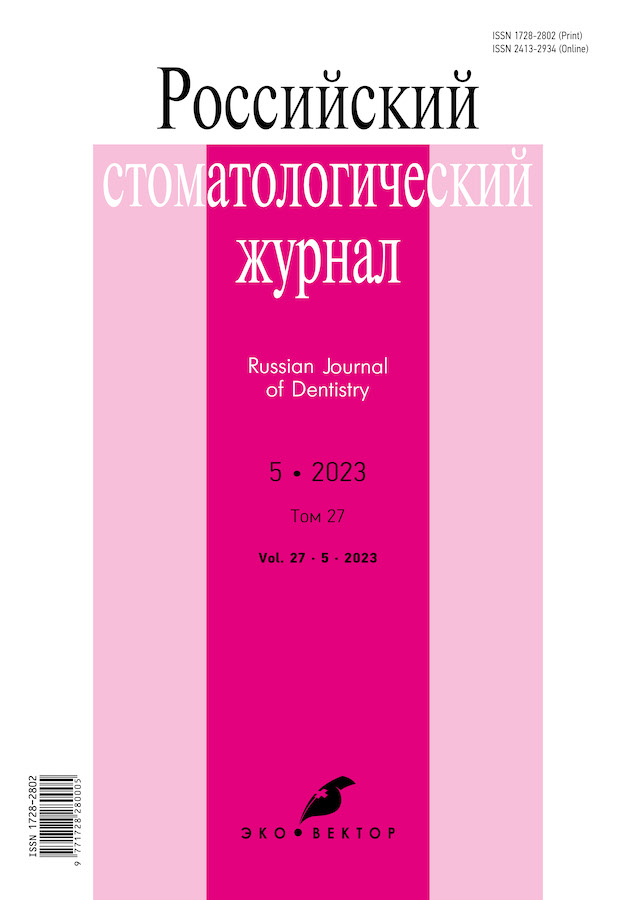Исследование динамики деминерализации временных зубов способами ультразвуковой теневой велосимметрии и аутофлуоресцентной микроскопии in vitro
- Авторы: Седойкин А.Г.1, Ермольев С.Н.1, Кисельникова Л.П.1, Затевалов А.М.2, Фокина А.А.1
-
Учреждения:
- Московский государственный медико-стоматологический университет имени А.И. Евдокимова
- Московский научно-исследовательский институт эпидемиологии и микробиологии имени Г.Н. Габричевского
- Выпуск: Том 27, № 5 (2023)
- Страницы: 385-394
- Раздел: Экспериментально-теоретические исследования
- Статья получена: 14.03.2023
- Статья одобрена: 05.11.2023
- Статья опубликована: 04.12.2023
- URL: https://rjdentistry.com/1728-2802/article/view/321362
- DOI: https://doi.org/10.17816/dent321362
- ID: 321362
Цитировать
Полный текст
Аннотация
Обоснование. В связи с высоким распространением кариеса у детей дошкольного возраста необходима актуализация дополнительных методов диагностики скрытых кариозных очагов с глубокой структурной деминерализацией твёрдых тканей временных зубов без генерации рентгеновского излучения.
Цель исследования — совершенствование методов изучения процессов деминерализации твёрдых тканей временных зубов способами ультразвуковой теневой велосимметрии и аутофлуоресцентной микроскопии.
Материалы и методы. В исследование включили временные вторые моляры (n=11). Образцы временных зубов помещали в пробирку с деминерализирующим раствором на 1, 4, 8, 21 и 31 сут. Исследования образцов проводили способами аутофлуоресцентной микроскопии и ультразвуковой теневой велосимметрии согласно времени экспозиции. Оценку степени кислотной деминерализации образцов временных зубов проводили согласно разработанной нами балльной шкале. Сравнение средних осуществляли с помощью W-критерия Вилкоксона (p <0,05). Корреляционный анализ Пирсона использовался с учётом статистической значимости коэффициентов корреляции для p <0,05.
Результаты. Исследование образцов твёрдых тканей временных зубов способом ультразвуковой теневой велосимметрии показало, что скорость прохождения ультразвуковой волны при увеличении экспозиции в деминерализирующем растворе падает и приобретает линейный характер с отрицательным коэффициентом регрессии. Снижение показателей скорости ультразвуковой волны в зоне эмали и дентина образцов имеет прямую корреляционную связь со степенью деминерализации.
Заключение. Эксперимент на твёрдых тканях временных зубов показал, что процесс деминерализации не только приводит к микроморфологическим структурным изменениям в твёрдых тканях эмали и дентина, но и влияет на физические (акустические) свойства образцов.
Полный текст
Об авторах
Алексей Геннадьевич Седойкин
Московский государственный медико-стоматологический университет имени А.И. Евдокимова
Автор, ответственный за переписку.
Email: alexdokt_01@mail.ru
ORCID iD: 0000-0001-6740-3363
SPIN-код: 2966-5210
кандидат мед. наук, доцент
Россия, 127206, Москва, ул. Вучетича, д. 9аСергей Николаевич Ермольев
Московский государственный медико-стоматологический университет имени А.И. Евдокимова
Email: ermoljev_s@hotmail.com
ORCID iD: 0000-0002-4219-3547
SPIN-код: 7109-4050
доктор мед. наук, профессор
Россия, 127206, Москва, ул. Вучетича, д. 9аЛариса Петровна Кисельникова
Московский государственный медико-стоматологический университет имени А.И. Евдокимова
Email: lpkiselnikova@mail.ru
ORCID iD: 0000-0003-2095-9473
SPIN-код: 2429-8388
доктор мед. наук, профессор
Россия, 127206, Москва, ул. Вучетича, д. 9аАлександр Михайлович Затевалов
Московский научно-исследовательский институт эпидемиологии и микробиологии имени Г.Н. Габричевского
Email: zatevalov@mail.ru
ORCID iD: 0000-0002-1460-4361
SPIN-код: 3718-6127
доктор биол. наук, профессор
Россия, МоскваАлександра Алексеевна Фокина
Московский государственный медико-стоматологический университет имени А.И. Евдокимова
Email: fokina.aleksandra@yandex.ru
ORCID iD: 0000-0003-0522-2860
SPIN-код: 7473-9750
аспирант
Россия, 127206, Москва, ул. Вучетича, д. 9аСписок литературы
- Macey R., Walsh T., Riley P., et al. Fluorescence devices for the detection of dental caries // Cochrane Database Syst Rev. 2020. Vol. 12, N 12. CD013811. doi: 10.1002/14651858.CD01381
- Седойкин А.Г., Кисельникова Л.П., Ермольев С.Н., Фокина А.А., Тома Э.И. Изучение методом ультразвуковой микроденситометрии зон эмали и дентина в постоянных зубах у детей // Труды Научно-исследовательского института организации здравоохранения и медицинского менеджмента: сборник научных трудов. 2022. № 2. С. 103–106.
- Mazur M., Jedliński M., Ndokaj A., et al. Diagnostic drama. Use of ICDAS II and fluorescence-based intraoral camera in early occlusal caries detection: A clinical study // Int J Environ Res Public Health. 2020. Vol. 17, N 8. 2937. doi: 10.3390/ijerph17082937
- Патент РФ на изобретение № 2790947C1/ 28.02.23. Седойкин А.Г., Фокина А.А., Ермольев С.Н., Кисельникова Л.П., Янушевич О.О., Текучёва С.В. Способ ультразвуковой велосимметрии для оценки состояния твёрдых тканей зубов.
- Chiena Y.C., Burwell A.K., Saeki K., et al. Distinct decalcification process of dentin by different cariogenic organic acids: Kinetics, ultrastructure and mechanical properties // Arch Oral Biol. 2016. Vol. 63. P. 93–105. doi: 10.1016/j.archoralbio.2015.10.001
- Бояркин Е.В., Кочетков А.С., Бехер С.А. Физические основы ультразвукового контроля. Руководство по подготовке к экзамену. Новосибирск : Изд-во СГУПС, 2018.
- Wang L.J., Tang R., Bonstein T., Bush P., Nancollas G.H. Enamel demineralization in primary and permanent teeth // J Dent Res. 2006. Vol. 85, N 4. P. 359–363. doi: 10.1177/154405910608500415
- Зацепин А.Ф. Акустический контроль / под ред. В.Е. Щербинина. Екатеринбург : Изд-во Уральского университета, 2016.
Дополнительные файлы














